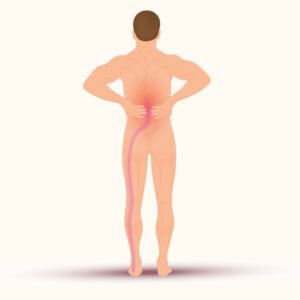Lumbago with sciatica is a prevalent and debilitating condition that affects millions of people worldwide. If you’ve ever experienced shooting pain down your leg, accompanied by lower back pain, you might be familiar with this condition. In this comprehensive article, we will explore the causes, symptoms, diagnosis, treatment options, and preventive measures related to lumbago with sciatica, also known as sciatic nerve pain.
Contents
Understanding Lumbago and Sciatica

Lumbago and sciatica are terms often used interchangeably, but they refer to distinct conditions. Lumbago, commonly known as lower back pain, originates in the lumbar region of the spine. On the other hand, sciatica is characterized by pain that radiates along the sciatic nerve, extending from the lower back through the hips and down each leg. Understanding the difference between these two is crucial for effective management.
Lower back pain or lumbago can occur due to various reasons, such as muscle strain, ligament sprain, or degenerative disc disease. Sciatica, however, is primarily caused by the compression or irritation of the sciatic nerve, often due to a herniated disc or spinal stenosis.
Causes of Lumbago and Sciatica
- Muscle Strain: One of the most common causes of lumbago is muscle strain or sprain. It can happen due to improper lifting, sudden movements, or overuse of the back muscles.
- Herniated Disc: Also known as a slipped or ruptured disc, it occurs when the soft gel-like center of a spinal disc pushes through a weak spot in the tougher outer layer, irritating nearby nerves and causing pain.
- Degenerative Disc Disease: As people age, the intervertebral discs in the spine can gradually degenerate, losing their cushioning effect, leading to lumbago.
- Spinal Stenosis: This condition involves the narrowing of the spinal canal, causing compression of the spinal cord and nerves, which can result in lumbago.
Causes of Sciatica:
- Lumbar Disc Herniation: When a disc in the lower back bulges or herniates, it can put pressure on the sciatic nerve, causing sciatica.
- Piriformis Syndrome: The piriformis muscle, located deep in the buttocks, can irritate or compress the sciatic nerve, leading to sciatica.
- Spinal Stenosis: Narrowing of the spinal canal can put pressure on the sciatic nerve and cause sciatica.
- Spondylolisthesis: When one vertebra slips forward over another, it can pinch the sciatic nerve and lead to sciatica.
- Degenerative Disc Disease: Age-related wear and tear on the discs can cause them to bulge or collapse, irritating the sciatic nerve.
Signs and Symptoms of Lumbago and Sciatica
These are some of the signs of lumbago and sciatica:
- Dull, Aching Pain: Lumbago typically presents as a dull, aching pain in the lower back. The pain may be localized or spread across the lower back region.
- Pain with Movement: The pain may worsen with certain movements, such as bending, lifting, or twisting.
- Stiffness: Individuals with lumbago may experience stiffness in the lower back, especially after prolonged periods of inactivity or upon waking up in the morning.
- Shooting or Radiating Pain: Sciatica is characterized by a sharp, shooting, or burning pain that radiates along the path of the sciatic nerve. The pain usually starts in the lower back or buttocks and travels down the back of the thigh and calf.
- Leg Pain Dominance: Unlike lumbago, sciatica pain is more prominent in the leg than in the lower back.
- Bowel or Bladder Dysfunction (severe cases): In rare, severe instances where there is significant compression of the nerves, sciatica can lead to bowel or bladder dysfunction, such as urinary or fecal incontinence. If this occurs, immediate medical attention is necessary.
Diagnosis
Diagnosing lumbago and sciatica involves a comprehensive evaluation of the patient’s medical history, a physical examination, and possibly additional diagnostic tests. The primary goal is to identify the underlying cause of the symptoms to provide appropriate treatment and relief. Here’s an overview of the diagnostic process:
- Medical History: The healthcare provider will begin by taking a detailed medical history, including asking about the patient’s symptoms, the onset of pain, any recent injuries, medical conditions, and family history of spinal problems.
- Physical Examination: A thorough physical examination will be performed to assess the patient’s range of motion, strength, reflexes, and sensation in the affected areas. The doctor will also look for any signs of nerve irritation or muscle abnormalities.
- Imaging Tests: In many cases, imaging tests are used to visualize the structures of the spine and help identify the cause of lumbago and sciatica. Common imaging tests include:
- X-rays: Useful for detecting bone abnormalities, fractures, or arthritis.
- Magnetic Resonance Imaging (MRI): Provides detailed images of the spinal structures, such as discs, nerves, and soft tissues, helping to identify herniated discs, spinal stenosis, or other issues.
- Computed Tomography (CT) Scan: Offers detailed cross-sectional images of the spine, helpful in identifying bony abnormalities or spinal stenosis.
- Electromyography (EMG) and Nerve Conduction Studies (NCS): These tests assess nerve function and can help determine if there is nerve compression or damage.
Traditional Treatment Options

Treatment for lumbago with sciatica usually begins with conservative approaches. Pain management techniques, such as hot or cold therapy, can provide relief.
- Physical therapy with targeted exercises helps strengthen the core and back muscles, reducing the pressure on the sciatic nerve.
- Medications like nonsteroidal anti-inflammatory drugs (NSAIDs) may be prescribed for pain and inflammation.
- Rest and lifestyle modifications, such as avoiding activities that exacerbate the pain, can aid in the healing process. However, in severe cases or when conservative treatments fail, surgical intervention may be necessary.
Alternative and Complementary Approaches
Alternative and complementary approaches can be used alongside conventional medical treatments to manage lumbago and sciatica. It’s important to consult with a healthcare professional before trying any new treatments to ensure they are safe and appropriate for your specific condition. Here are some alternative and complementary approaches that may provide relief for lumbago and sciatica:
- Chiropractic Care: Chiropractors use hands-on spinal manipulation to help improve spinal alignment, reduce nerve irritation, and alleviate back pain.
- Acupuncture: An ancient Chinese therapy involving the insertion of thin needles into specific points on the body to balance the flow of energy (Qi) and promote pain relief.
- Massage Therapy: Therapeutic massage can help relax tight muscles, improve blood circulation, and reduce pain in the lower back and legs.
- Yoga and Stretching Exercises: Gentle stretching exercises and yoga poses can help improve flexibility, strengthen the core and back muscles, and alleviate back pain.
- Physical Therapy: A physical therapist can design a customized exercise program to improve mobility, posture, and overall function while reducing pain.
Surgical Interventions
Surgical interventions for lumbago and sciatica are typically considered when conservative treatments have failed to provide relief, and the pain or neurological symptoms are severe or progressively worsening.
The decision to undergo surgery depends on the specific underlying cause of the condition, the severity of symptoms, the overall health of the patient, and their individual preferences. Here are some common surgical procedures for lumbago and sciatica:
- Discectomy: This procedure involves the surgical removal of a herniated or ruptured disc that is pressing on the spinal nerves, causing sciatica. It can be performed through traditional open surgery or minimally invasive techniques.
- Microdiscectomy: A minimally invasive version of a discectomy, where a small incision is made, and specialized instruments are used to remove the portion of the herniated disc that is causing nerve compression.
- Laminectomy: In cases of spinal stenosis, a laminectomy may be performed to relieve pressure on the spinal cord and nerves. It involves removing a portion of the lamina (the bony arches of the vertebra) to create more space in the spinal canal.
- Spinal Fusion: This surgery is often performed to stabilize the spine in cases of degenerative disc disease, spondylolisthesis, or severe spinal instability. It involves joining two or more vertebrae together with bone grafts or metal hardware
Sciatica and Lumbago in Pregnancy

Sciatica and lumbago can occur during pregnancy due to the physical and hormonal changes that take place in a woman’s body. These conditions can cause discomfort and pain in the lower back, hips, and legs during pregnancy. Here’s how they are related to pregnancy:
Sciatica in Pregnancy
Sciatica during pregnancy is primarily caused by pressure on the sciatic nerve, which is the largest nerve in the body. The sciatic nerve runs from the lower back, through the hips and buttocks, and down each leg.
As the uterus expands during pregnancy, it can put pressure on the sciatic nerve, leading to inflammation and irritation. Additionally, hormonal changes during pregnancy can cause increased joint laxity, which may contribute to the compression of the sciatic nerve.
Symptoms of sciatica during pregnancy may include shooting or burning pain that radiates from the lower back down the buttocks and one or both legs. It may also be accompanied by tingling, numbness, or weakness in the affected leg. The pain may worsen with prolonged standing, sitting, or walking.
Lumbago in Pregnancy
Lumbago, or low back pain, is a common complaint during pregnancy. As the baby grows, the center of gravity of the pregnant woman shifts, causing changes in posture and increased pressure on the lower back.
Hormonal changes during pregnancy can also affect the ligaments and muscles that support the spine, leading to back pain.
Symptoms of lumbago during pregnancy may include dull, aching pain in the lower back. The pain may be aggravated by certain movements or activities, and it may be more pronounced towards the end of the day or after prolonged periods of sitting or standing.
Conclusion
Lumbago with sciatica can significantly impact one’s quality of life, but understanding the condition and taking appropriate measures can lead to better management and improved well-being. If you experience symptoms of lumbago or sciatica, don’t hesitate to seek professional medical advice. Early diagnosis and appropriate treatment are essential for faster recovery and better long-term outcomes.
Physical Therapy helps patients recover from pain. If you’re experiencing Foot, Back, Shoulder, Knee, Neck, Elbow, Hip, or Arthritis pain, a physical therapist at PhysioMantra can help: Book an online physical therapy session.



